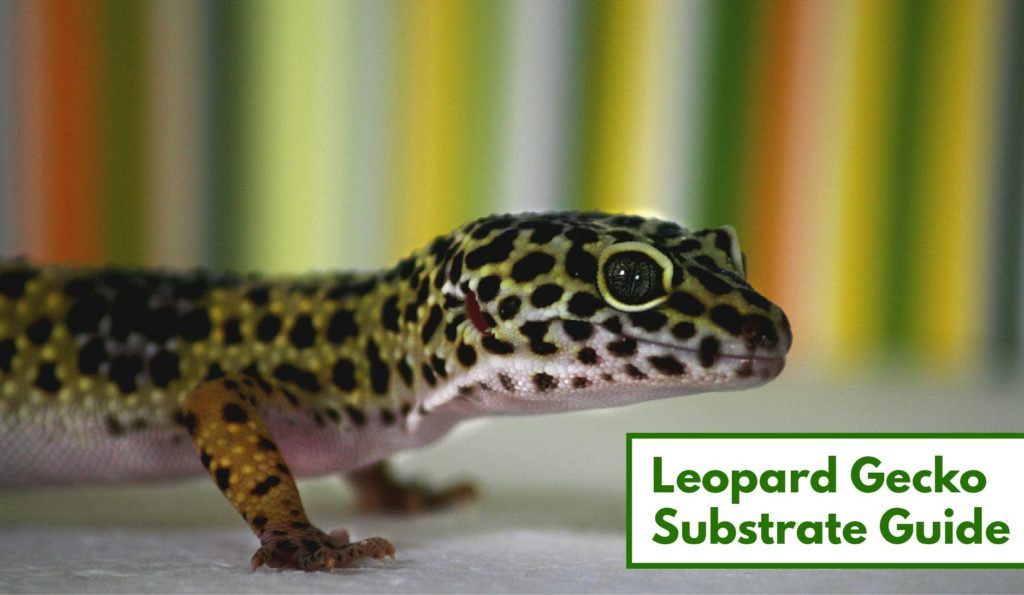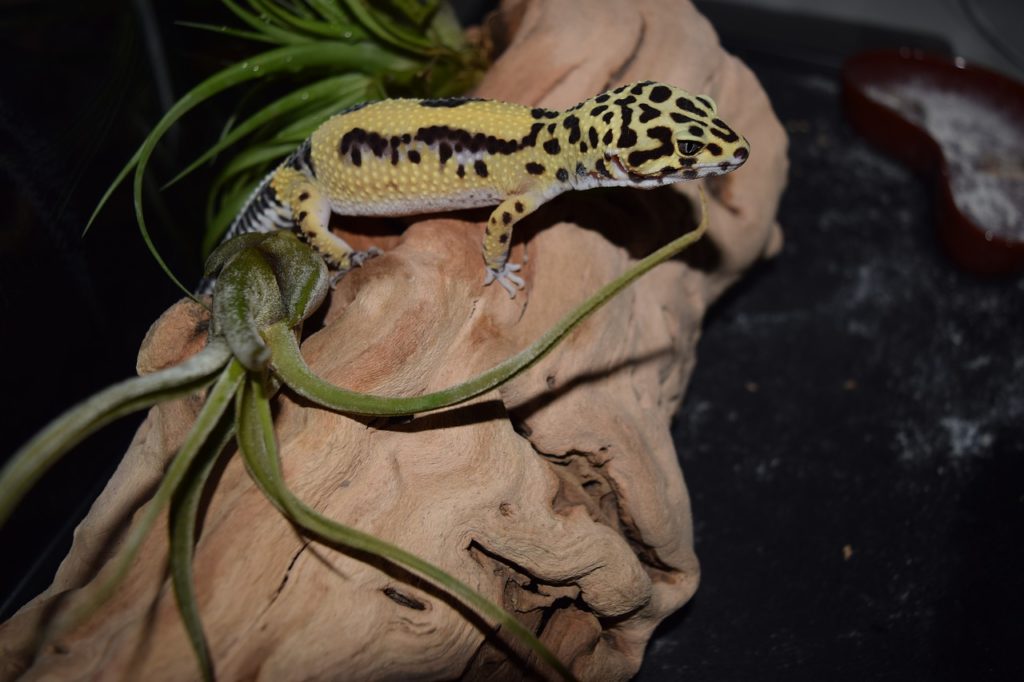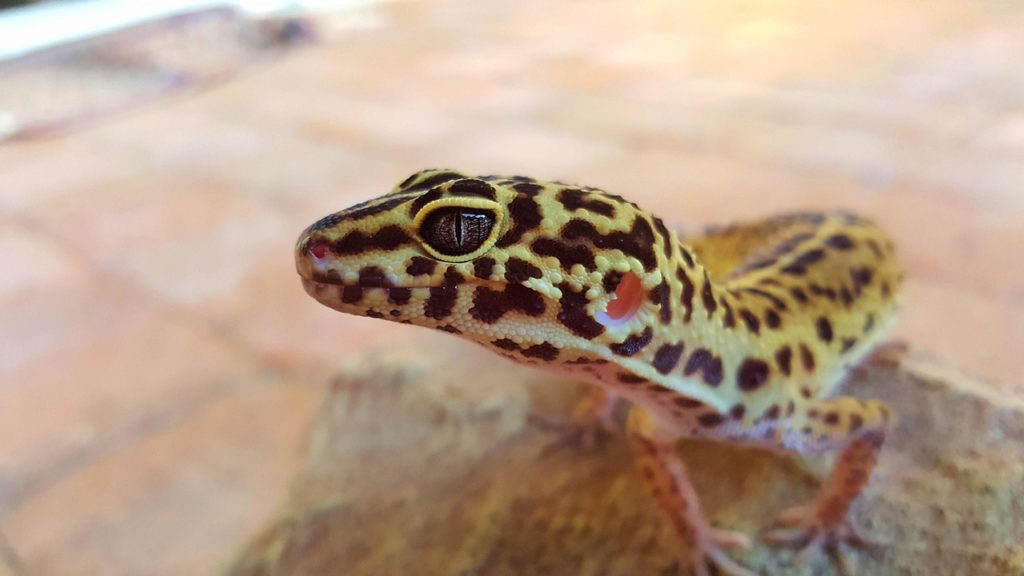When choosing a substrate for your leopard gecko terrarium, there are many options available. However, making the wrong choice could lead to serious health problems down the road.
As a result, it’s extremely important to consider all factors of the substrate before making a decision.

The best substrate for your leopard gecko may also vary depending on the age and size of the lizard. The ideal leopard gecko substrate will be compact, easy to clean, and impossible to accidentally ingest.
Read on for a breakdown of various substrates and their suitability for leopard geckos.
Quick Navigation
Setting up an Ideal Leopard Gecko Habitat
Like most lizards, leopard geckos are pretty specific about their habitat needs.
They prefer horizontally-oriented tanks with heat lamps, a humidity range of about 25-45%, and temperature ranges of 65-85°F.
The ideal habitat will also feature some plants (real or artificial) to provide shade and hiding spots as well as a shelter for sleeping and cooling down.
Glass tanks (20 gallons in size) are preferred over wire, as the gecko’s feet can get caught in the wiring.
Leopard geckos are generally fed mealworms and crickets. When eating live prey, geckos are known for getting very excited about the hunt (often chasing prey around their habitat for quite a while).
Unfortunately, sometimes these specialized tongues also pick up pieces of harmful substrate when eating.
During digestion, loose substrate may compact in the intestines, causing digestive distress which can eventually lead to death.
This is where having the right type of substrate can be a life or death factor for your Leopard Gecko.

Considering purchasing a Leopard Gecko? Check out our step-by-step Leopard Gecko setup guide for more info!
Leopard Gecko Substrate Requirements
Substrate is the material which is placed in the bottom of the tank as bedding and flooring.
This material will be walked on, laid on, and will catch the waste produced by the geckos.
The frequency with which the substrate is cleaned or changed will depend upon the type of substrate used.
Obviously, leopard gecko substrates should be safe for geckos to eat food off of and lay on.
But it is also nice to find substrates that are easy to clean up and/or replace, in order to reduce the required tank maintenance and cost of habitat upkeep.
The substrate should also be non-irritating to the gecko’s skin, and should not encourage the gathering of dust which can irritate the gecko’s respiratory system.
Preventing Impaction in Leopard Geckos
Impaction is a very real health threat to many domesticated lizards, including leopard geckos.
Impaction occurs when a foreign substance is ingested and cannot pass through the lizard’s digestive system, creating a backup.
Geckos suffering from impaction will stop eating, stop defecating, and gradually lose weight.
This is a common and life-threatening affliction, which can be treated if caught early on, but in many cases impaction is not diagnosed until it is too late.
Before going any further, it is important to point out that the biggest culprit of accidental ingestion and impaction of substrate for leopard geckos is sand.
Sometimes sand will be recommended because it is easy to scoop out refuse, and geckos are fond of burrowing in it.
However, the risks far outweigh the benefits, and for this reason sand is not discussed as a suitable substrate in this article.
Sand mats are also not recommended, because even though the sand and rocks are “cemented” to the mat and should not be able to come loose, there is still a risk that the substrate could be ingested.
7 Best Leopard Gecko Substrates

Here are a few types of leopard gecko substrate that we recommend:
1. Reptile Carpet
One of the most popular substrates for its ease of use, reptile carpet is a safe and attractive substrate for leopard gecko tanks.
I recommend Zilla Terrarium Liner.
- LOW-MAINTENANCE AND EASY TO CLEAN, perfect for beginner pet owners. Simply rinse with cold water to...
- ODOR-REDUCING TERRARIUM LINER. Treated with an enzyme that minimizes reptile odors and contributes...
- DESIGNED TO BE SAFE so that your reptile cannot accidentally ingest the bedding when feeding. An...
Most reptile carpets are soft on the top so they don’t irritate the lizard’s skin.
The reverse side of the liner is stiff and absorbent, making it ideal for leopard geckos. It can’t be eaten, making it a safe and attractive choice for substrate.
Reptile carpet is easy to clean, and can be removed and washed a few times before replacing. It is important to replace the reptile carpet often (according to the packaging), as the material’s fibers can become loose and may get caught in gecko toes.
Tip: If you take a hot iron and give your reptile carpet a quick one-over, it can help eliminate the fiber curls and reduce the risk of your Gecko’s toes getting caught up!
- Cleaning/maintenance: Spot clean daily (remove fecal matter), wash according to directions on package approx. 2-3x per month. Replace as needed, approx. after 3-4 washes or when fibers become loose.
- Risk of impaction: None. Slight risk of getting toes caught in fibers, but only if the carpet is overused.
2. Newspaper
A less attractive but equally safe option, newspaper is an affordable substrate, preferred by many owners for baby geckos. It must be replaced daily in order to avoid bacterial growth or risk of infection, but newspaper is easy to find and replace at a lower cost than many substrates. It cannot be ingested, making it much safer than sand.
Newspaper is a good substrate to have on hand for juvenile geckos, or if the normal substrate cannot be replaced immediately.
- Cleaning/maintenance: Replace wet or soiled newspaper as it is soiled. Replace all newspaper lining 1-2x per week.
- Risk of impaction: None.
3. Paper Towels
Paper towels are a favorite among leopard gecko owners, for several reasons. They may not be the most attractive substrate, paper towels make it easy to see where waste and soiled areas need to be replaced. This helps maintain a safe and healthy habitat for your geckos.
Paper towels are soft enough to not irritate the gecko’s skin. They are also easy to replace once soiled, and they do not pose a risk of ingestion or impaction. Paper towels may not be the most attractive substrate, but as far as health and safety they are at the top of the class.
The only downside is that paper towels are not a natural substrate, and may be disappointing for geckos who enjoy burrowing. However, burrowing habits vary based on the individual gecko, so it is up to you whether your gecko would miss the chance to burrow or if they would be equally happy with a solid bedding surface.
- Cleaning/maintenance: Replace wet or soiled newspaper as it is soiled. Replace all newspaper lining 1-2x per week.
- Risk of impaction: None.
4. Prepackaged Bedding
Many types of pre-packaged bedding exist, some claiming to be the best for geckos because they are “native to the gecko’s natural environment”, such as crushed/shredded shells, coconut, etc.
The issue with these substrates is very similar to the issue with sand: it is very easy for the gecko to accidentally ingest small pieces of the substrate, causing impaction.
Some of these pre-packaged substrates might be usable for adult geckos. Zoo Med Eco Earth, for example, is a great option that is often considered safe for geckos.
That being said, sand, dirt, and wood chips should be avoided entirely.
Additionally, even the few pre-packaged substrates that may be usable for adults can be a hassle to clean.
- Cleaning/maintenance: Varies greatly depending upon specific bedding type. Follow directions on packaging.
- Risk of impaction: Moderate, but depends greatly on type of bedding. Never use woodships, shells, or nuts.
5. Stones and Slate
As mentioned, anything small that can be accidentally ingested (such as tiny stones or rocks) should be avoided.
However, some owners use large stones or pieces of slate to create a natural-looking habitat with basking spots and hiding spots.
These are excellent to use as décor, but should be paired with another substrate (reptile carpet, paper, etc.- not sand!) for ease of cleaning and for safety reasons.
- Cleaning/maintenance: Spot clean as needed/daily; remove from tank and clean monthly.
- Risk of impaction: None.
6. Tile Flooring
Tile is a nice alternative to many substrates, as it retains heat well and is easy to clean and maintain.
With tiles made of slate or ceramics, there is no risk of impaction because the tile is (obviously) inedible.
Tiles do not need to be replaced unless they break, meaning that in the long term these are a cost-effective substrate option. They are also more visually appealing than newspaper or paper towels, but they are just as safe.
- Cleaning/maintenance: Spot clean as needed/daily; remove from tank and clean monthly.
- Risk of impaction: None.
7. Shelf Liner
- EXTRA STRONG GRIP NON-ADHESIVE LINER: the Gorilla Grip powerGRIP liner is a non adhesive and tear...
- KEEP ITEMS IN PLACE: thick and durable Gorilla Grip Drawer and Shelf Liners line your drawers and...
- REFRESH YOUR DRAWERS AND SHELVES: add a quick refresh to any surface for a beautiful transformation...
Shelf liners (commonly used in kitchens and bathrooms) are an alternative substrate which can be used for leopard geckos. It is easy to clean and is cost-effective. The most important things to consider with shelf liner is to find one that is non-adhesive (for easy cleaning and removal as well as prevention from bugs getting trapped under the substrate), and making sure that it will not irritate the gecko’s skin.
Shelf liner can breed bacteria if not cleaned effectively. As a result, you may want to add paper towels atop the liner just for ease of cleaning and to keep the tank healthy.
- Cleaning/maintenance: Spot clean as needed; wipe down weekly. Should be replaced every 1-2 months depending upon the type of liner and ease of cleaning.
- Risk of impaction: None.
Leopard Gecko Habitat Tips and Tricks
Here are a few other things you should be aware of when setting up a leopard gecko habitat:
Hide Boxes
- Gecko Cave that provides a secure hiding for reptiles and amphibians
- Integrates easily in desert and tropical terrariums
- Having a resting place helps alleviate stress in reptiles and amphibians
It is important to include at least one hide box in any leopard gecko enclosure.
Leopard geckos shed their skin somewhat frequently, and require a hide box with high humidity to make this process easier.
Filling the hide box with moss or another moist material can help keep the humidity in the hide box high.
Mites
Mites are a common nuisance for reptiles (and by extension, reptile owners). They are a type of ectoparasite that live on the outside of reptile’s skin and feeds off of their blood, much like ticks or leeches.
It is common for these mites to appear in the tank at some point, depending on the humidity level and substrate type.
Fortunately, it is possible to stave off mites by maintaining a clean and healthy cage environment.
The more frequently the cage is cleaned and the substrate replaced, the less likely it is for mites to infest the area.
If you do have a mite infestation, the tank should be cleaned thoroughly and treated with diluted bleach and an animal safe insecticide. The gecko should be brought to the vet for assessment and treatment.
Final Thoughts
Leopard geckos are fun and easy reptiles to keep. However, it is crucial to understand the dangers that the wrong equipment and habitat conditions can pose. One of the highest risks for domestic leopard geckos is the risk of impaction. Fortunately, it is easy to avoid the risk of impaction by selecting a suitable substrate and maintaining a clean and healthy habitat. This will lead to a long and happy life for your little geckos!
Last update on 2026-01-01 / Affiliate links / Images from Amazon Product Advertising API



I never knew that choosing the wrong substrate choice for your gecko’s terrarium could lead to serious health problems. My husband needs to know about this. He told me recently that he wants to buy a pair of leopard gecko to add up to his collection of exotic pets. He also asked me to help him find a good terrarium in which he can place the geckos. Hopefully, we can find a good store that has a good quality substrate for a gecko terrarium.
If you are putting the geckos in the same tank, please do not put two males together, a male and a female, or an adult gecko and a young gecko together.
All in all, Leopard Geckos do better living on their own in their own tanks, but in some circumstances, two female geckos of the same age can be housed together in the same tank.
I have a Leopard Gecko named Queso 🙂
The substrate I use for my Leopard Gecko is Eco Earth. It is harmless and allows the gecko to dig around (which they sometimes like to do) and it’s also pretty cheap.
Something to keep in mind about Reptile Carpet, paper towels and newspaper:
Leopard Geckos like to dig sometimes and these substrates don’t let them do that. Also, their nails can get stuck in the fibers of reptile carpet and also on a non moving substrate, the poop stinks a LOT more.